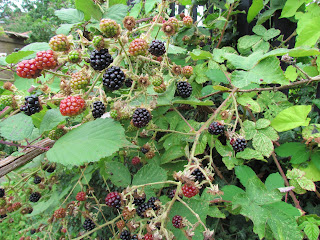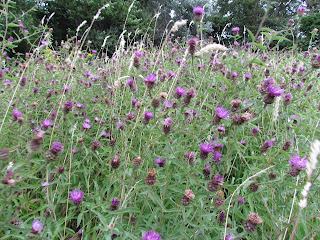Introduction
The last few months have been really busy for me with the
main wildlife survey season in full swing but Saturday 13th August was
a quiet time so I popped along to Church Farm to view the fields, hedgerows and
streams, at a time when summer is starting to wane and signs of autumn begin
appearing.
I followed a route around the edge of the main field
starting along the railway line, where the headland is currently 10 – 30 metres
wide.
It is worth mentioning that in May the government appointed planning
inspector confirmed what I had already assumed in January, namely that all of three
proposed new main housing areas for Paddock Wood (Church Farm, Mascalls Court
farm & Mascalls Farm) will be allowed to be developed over the next ten
years.
The Railway edge
Wandering along the northern edge of Church farm the many
blackberries were dark in colour, juicy in the mouth & sweet on the tooth.
One or two damson trees displayed ripening drupes and I spotted an apple tree
with apples still needing a month or so to swell and redden. The headland along
this stretch is at its widest, some 30 metres in places and as such has a
richer variety of wildlife to view.
The area was covered in late summer wildflowers and arable
weeds, fleabane and ragwort forming colourful expanses of bright yellow blooms
swaying in the light wind. The flowers were full of honey bees and bumble bees,
plus hoverflies in smaller numbers. The path and crop edges contained many
arable weeds; mayweed, feverfew, scarlet
pimpernel, creeping thistle, spear thistle, bistort & hawkweed amongst
them.
Further along a larger patch of common knapweed proved to be a great
attraction for red tailed and buff tailed bumblebees, grabbing the last of the
pollen and nectar before the colonies break up and new queen bees seek
abandoned small mammal burrows to hibernate in until the early 2017 spring
sunshine causes them to wake again.
Along the railway land boundary the poplar trees reach ever
towards the sky, but it’s the call of their leaves which attracts me, for in
the slightest breeze they flutter in unison and whilst being far from water
they give you the feeling of being next to a gentle waterfall. I’m not sure at
present what species of poplar or aspen they are, more investigation is needed
for there are many cultivars and types produced by the horticultural trade, but
on the ear they are a favourite of mine.
East Rhoden Stream
What was apparent, compared to my winter visit, was the much
reduced water flow. The Tudeley Brook to the west of Paddock Wood keeps flowing
at a steady rate throughout the year, as it rises in the High Weald and flows
towards the River Medway. It would seem that the water in the East Rhoden
stream is more of a drainage ditch, draining the lower area surrounding the
eastern side of Paddock Wood and so during drier periods of the summer the
water flow in much reduced.
Having said this the damp ground around the stream allowed a
good number of late summer flowering plants to be on show, such as Purple
Loosestrife, Greater Willowherb, Meadowsweet
and various species of rush & umbelifers. I also noted a couple of starwort
species in the water.
Bird life was sparse, as was any signs of mammals, apart
from human activity.
Human Presence on the site
Along the northern edge of the field I had noted a large
campfire area, with burnt logs and food rubbish.
There was also a kids rope
swing across the East Rhoden stream. Further along, in a southern wooded area
of the East Rhoden stream, a more permanent presence was in evidence, with a
tent and associated rubbish thrown in the stream.
Around the whole site a reasonable amount of dog poo could
be found along the paths and indeed a rather amusing incident occurred along
the southern path, bordering the Paddock Wood cemetery. Here two dog walkers
came walking along when one of the dogs squatted. The owner saw me and got out
a plastic bag to collect the doggy deposit. I walk past the couple and turned
south along the middle field ditch. The dog’s owner, seeing that I had past
their dog, put the plastic bag back in her pocket, unused, and left said dog
deposit on the path !
The southern edge & middle field ditch
Of note along the southern edge was the abandoned pear tree
orchard, with fruit in evidence. The crematorium hedge had been trimmed, so any
berries had subsequently been removed, leaving little food for the birds this winter, which was
disappointing to see.
The middle field ditch held no water for its entire length,
but was merely damp at the bottom. There was a good clump of purple
loosestrife, two horseradish plants and one or two patches of bramble, but
little else worthy of comment.
However the pond near the line of polar trees, whilst containing
no clear stretches of water did have a good growth of emergent pond vegetation.
Summary
The summer visit matched my winter walk in terms of wildlife
sittings. The areas of interest remain the boundaries of the site with the middle
of the field, being a forest of broad beans, having little opportunity for wildlife to establish a
permanent presence. The best wildlife area remains the northern boundary
alongside the railway line, but the East Rhoden stream was a little disappointing
and I had hoped it would hold more wildlife promise.
Professional surveys of the abandoned orchard have revealed
dormice in this area last year, although I did not have the time to review this
area in this visit. The other area I wasn’t able to explore was the land
bordering Church Farm itself, but being rough grassland I suspect it holds more
opportunities for wildlife than much of the rest of the site. Will have to see
if I can find the time to study these areas in more detail, in the coming
weeks.























No comments:
Post a Comment